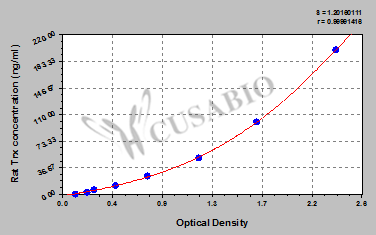The Rat Thioredoxin (Trx) ELISA Kit is a highly sensitive and specific assay for the quantitative detection of Trx in serum, plasma, and tissue homogenates from the Rat species.
Trx is a multifunctional protein that plays a vital role in maintaining cellular redox balance by acting as a reducing agent. Abnormal Trx levels have been linked to a variety of pathological conditions, including oxidative stresses,cancer, neurodegenerative diseases and cardiovascular disorders. This Trx ELISA Kit offers a reliable and efficient means of measuring Trx levels in biological samples, with a detection range of 3.12 ng/mL to 200 ng/mL and a sensitivity of 0.78 ng/mL.
The assay principle of our Trx ELISA Kit is based on the sandwich method. During the assay process, Trx in the sample is sandwiched between two Trx-specific antibodies, which are coated on the plate. The bound Trx is then detected using a detection antibody conjugated with HRP and a chromogenic substrate, producing a colorimetric signal that is directly proportional to the Trx concentration.
Our Trx ELISA Kit offers a quick assay time of 1-5 hours, with a sample volume of 50-100ul and a detection wavelength of 450 nm. It is suitable for use in metabolism and oxidative stresses research,has been optimized for use with Rat samples. Its quantitative assay principle, coupled with its wide detection range and high sensitivity, make it an invaluable tool for researchers studying the physiological and pathological roles of Trx in cellular metabolism.




